Art World
Kristin Walsh Shines a Gleaming Light on the Subterranea of Mass Transit
The artist has an unflinching, heavy metal take on the architecture and power dynamics of the subway system. Her industrial sculptures are on view at Petzel in New York.
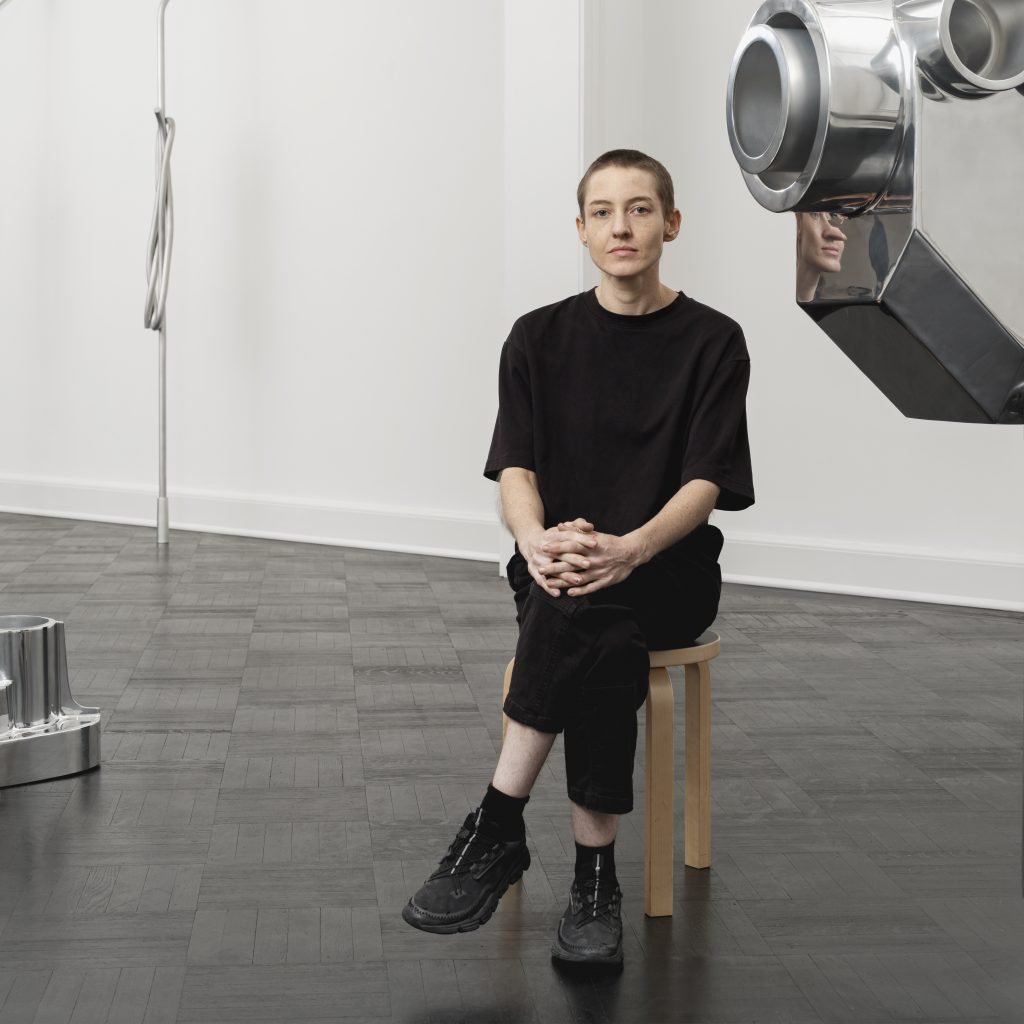
In an era when outsourced fabrication is expected, Kristin Walsh is surprisingly hands-on. She does her own welding on her gleaming mass-transit-inspired sculptures that form her recent practice. “For a long time I thought that I was more of a designer,” she said. “But it’s more that I make art about design. I use the language of design, but it’s not design because what I make doesn’t do anything. My work’s in conversation with the history of the city and designed objects in general.”
Her first solo exhibition, at Petzel’s Upper East Side locale, consists of eight aluminum forms that faithfully replicate the language and scale of mass-produced instruments. Three resemble train engines and five mimic apparatuses like subway turnstiles, globes, and poles. As much as Walsh’s glittering silver sculptures look like machines, they’re entirely non-functioning. And while one might assume they’re the product of computer-driven precision, Walsh in fact makes them by hand. They’re fantasy objects concerned with engaging histories of design, movement, and futility.
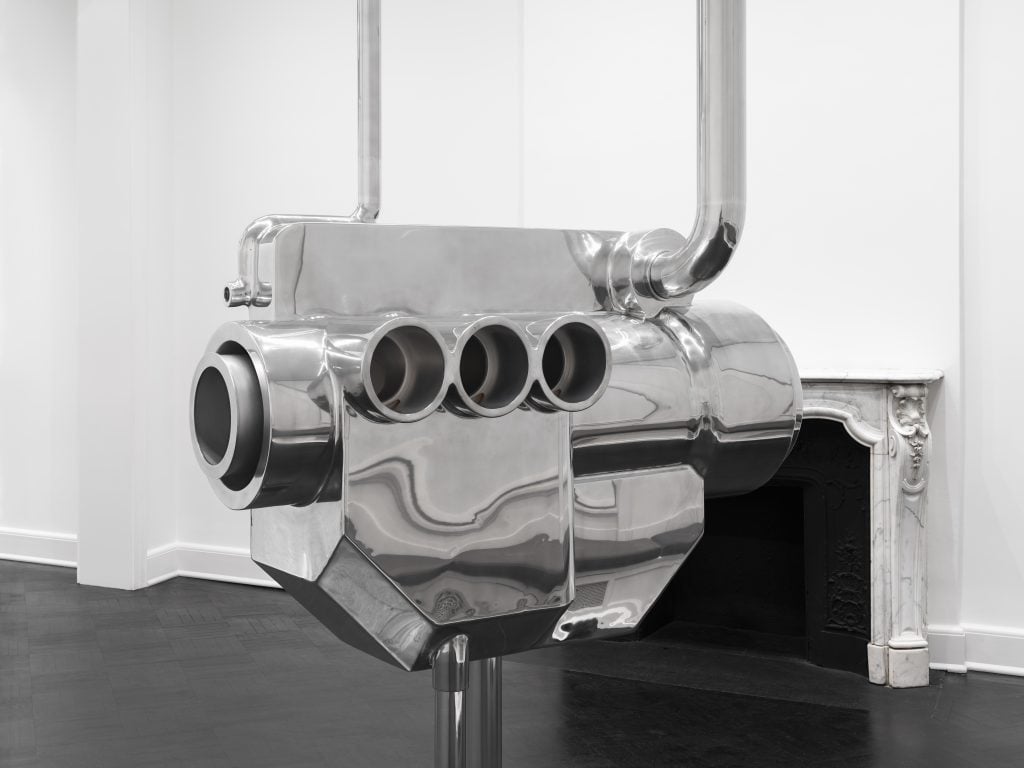
Kristin Walsh, Engine no. 12, (2024). Photo: Sebastian Bach. Courtesy the artist and Petzel, New York.
“The working end” runs until October 19. The 35-year-old artist hails from North Carolina, but is based in New York and is influenced by the MTA as well as the city’s defensive architecture: hostile methods in the built environment to, at once, retain the utility of public infrastructure while imposing limitations and social control. For example, benches that allow users to sit, but prevent them from lying down to discourage unhoused people from resting. While Walsh is interested in the systematic cruelties of design, her work is not all industrial coldness.
The cryptic inclusion of matches and dice within her sculptures complicates their interpretation. Embedding small objects like secrets into the works’ recesses and cavities rewards viewers who take a closer look. Sometimes these elements are kinetic, thanks to magnets and motors, but moving as if of their own accord, and periodically filling the gallery with ghostly noises. I caught up with Walsh last week to discuss this new body of aluminum sculpture and what led to their creation.
I’ve been seeing images of this sculpture, Engine no. 12, a lot on Instagram.
It’s the first piece that I started making for this show. It’s a loose interpretation of a diesel train engine. Engines are something that I make a lot of. This body of work was formed around ideas of defensive architecture in the MTA. Defensive architecture has this dual purpose and I’m reinterpreting dual purposes in things that you could come in contact with. Engine no. 12 was modeled off of a train diesel engine that produced poisonous fumes. I was looking at a lot of pictures of those engines, just absorbing the language of how they’re made, and then making them from memory. What I made doesn’t look exactly like a diesel engine.
It looks very finished, polished, and perfect. But to a trained eye, you can see your hand in the work.
It’s kind of a joke about artistic labor.
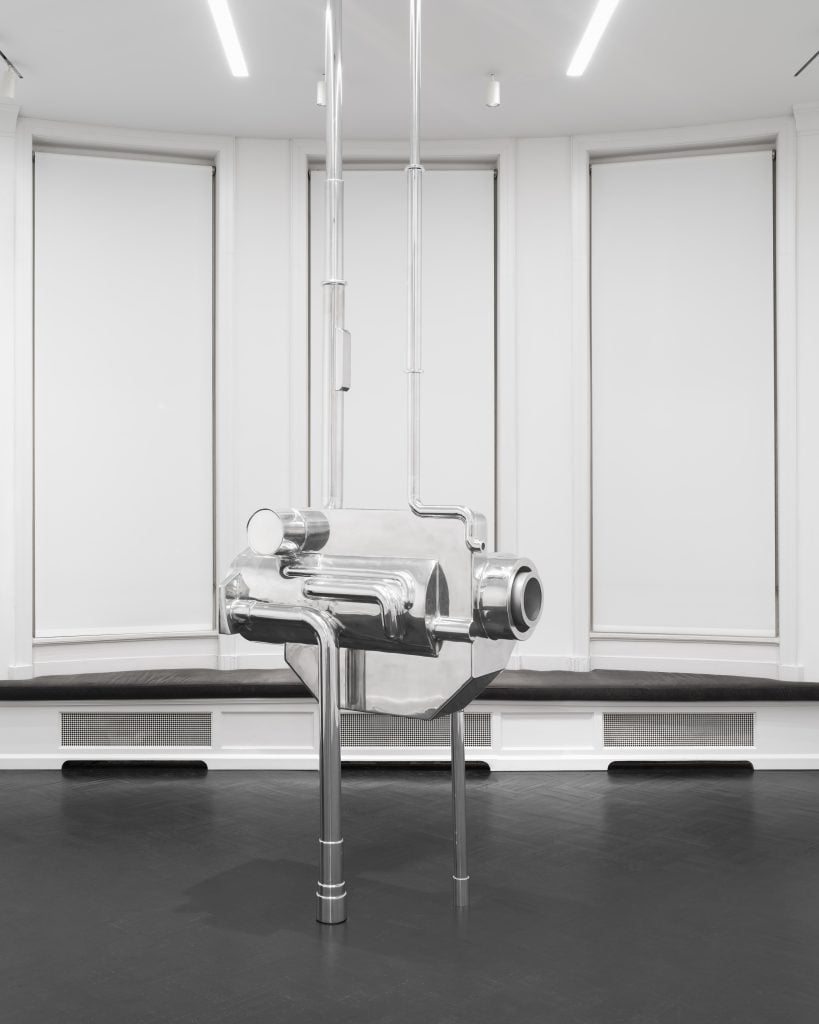
Kristin Walsh, Engine no. 12, 2024 Photo: Sebastian Bach. Courtesy the artist and Petzel, New York.
It feels very human. The kinetic elements seem to reference the body. The noises the matches made transform the engine into a diseased, rattling lung.
With Indicator no. 6 the all-over placement of the matches makes it like an infected body. The indicators fall into a category of indicating movement, and the engines are more like artifacts. These are the two avenues that I’m currently working with. I was looking a lot at this [2018 architecture] book called The Handbook of Tyranny: It’s about the similarities in planning the movement of a city, a war, or a slaughterhouse. The methods are the same, regardless of if it’s an Ikea or an abattoir. I’m interested in that dynamic, especially with the MTA train system. The politics surrounding the train takes the temperature of the city. Like what we’re feeling always plays out on the train.
Even though the work is enigmatic, I didn’t walk away from this show thinking that it was without feeling. I felt it was deeper than its visual coldness. I have to mention Richard Serra. Even though his sculptures are big and monumental, there’s a bodily element.
It’s all about the body with his work. I just wanted to mimic the architecture within the train. Everything has a floor-to-ceiling tension, like a sandwiching effect.
The sculptures serve as specific obstructions that mark moments in this space. I feel like this speaks to the physical heft of the work. How important is their weight?
It affects how they’re installed but that’s about it. Currently I use aluminum for everything. I think it’s really important to not generate excess waste. Aluminum is 99% recyclable. I keep that in mind when I’m working.
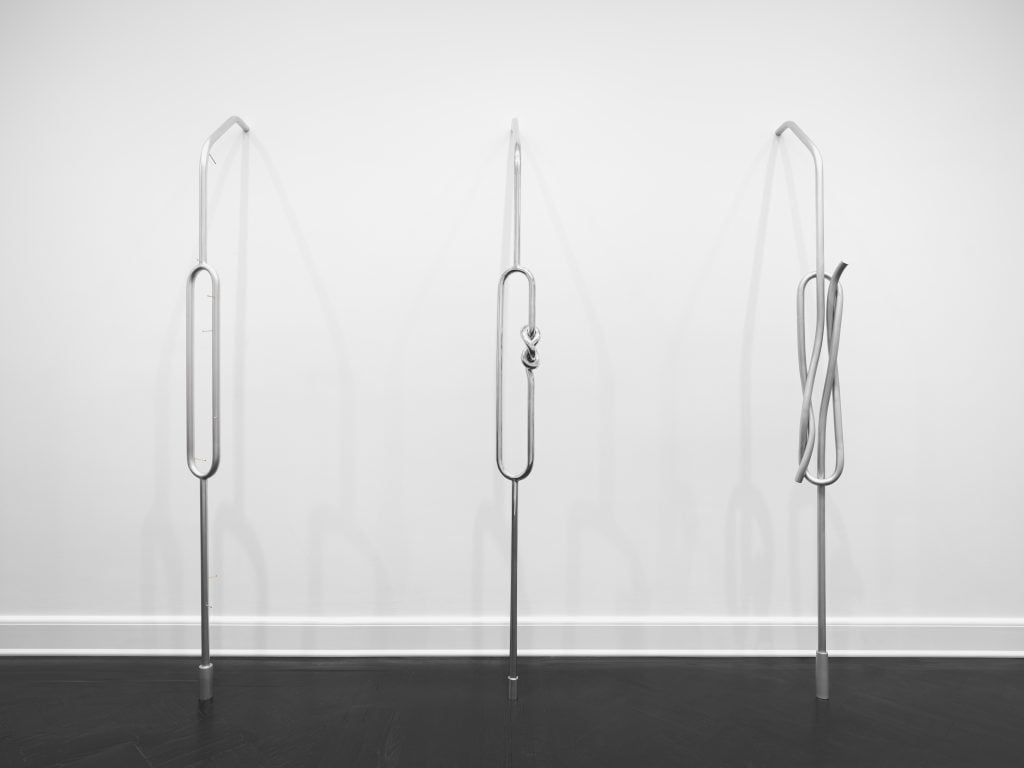
Installation view, Kristin Walsh, “The working end,” Petzel, 2024. Photo: Sebastian Bach. Courtesy the artist and Petzel, New York.
Tell me about the Indicator series you have on the wall?
These works are based around the idea of animal traps and defensive architecture. The MTA started to replace all of the original subway poles with these new ones to prevent “Showtime” [unsanctioned acrobatic performances ]. It’s under the auspices of making travel better for us, but we know it’s never about making things better for us. While one of the big engines can take up to five months to create, I can make these Indicators a lot faster. I really enjoyed making these. Indicator no. 5 was a bit harder to make because the shape is so specific. It’s literally the exact dimensions of a turnstile. Nothing changed about it. We come into contact with it every day but people don’t even recognize what it is.
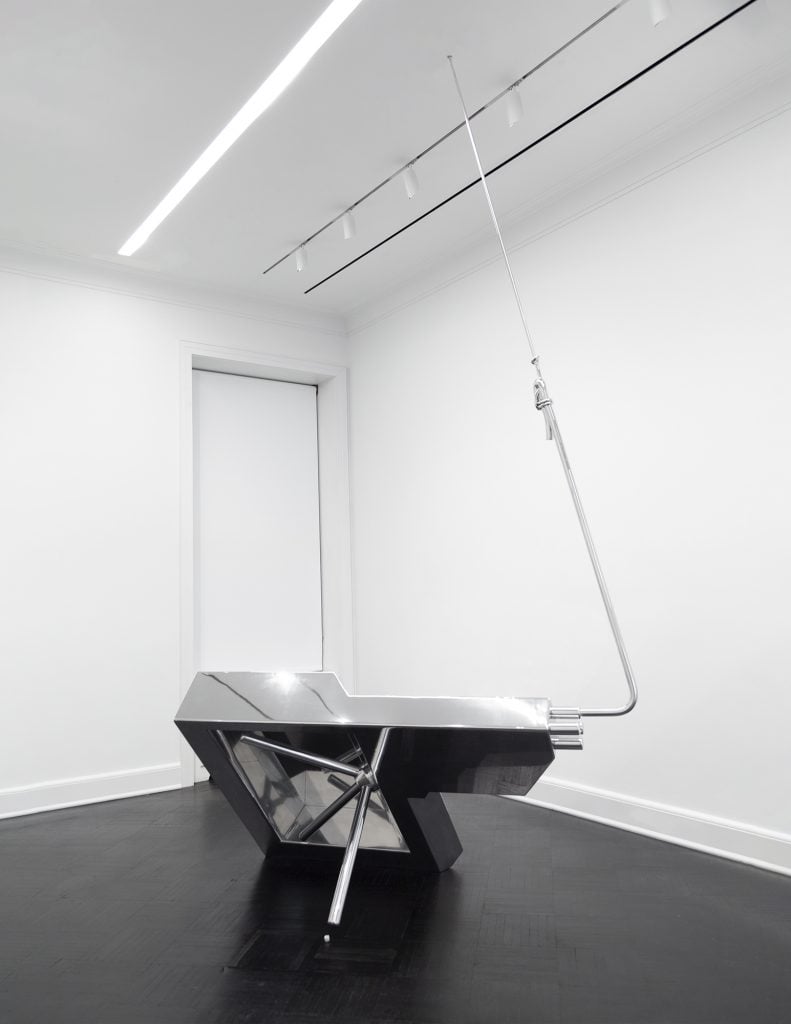
Kristin Walsh, Indicator no. 5 (2024). Photo: Daniel Polonsky. Courtesy the artist and Petzel, New York.
The matches are interesting within that sculpture, Engine no. 11.
This one is specifically modeled after a birthday cake, so the matches are like celebratory candles, but candles on an outdated form of technology. I know it doesn’t read like a birthday cake. I set up these technical parameters that I try to adhere to. I made some works in the past that took inspiration from brass instruments. The technical form was sifted through the idea of an engine.
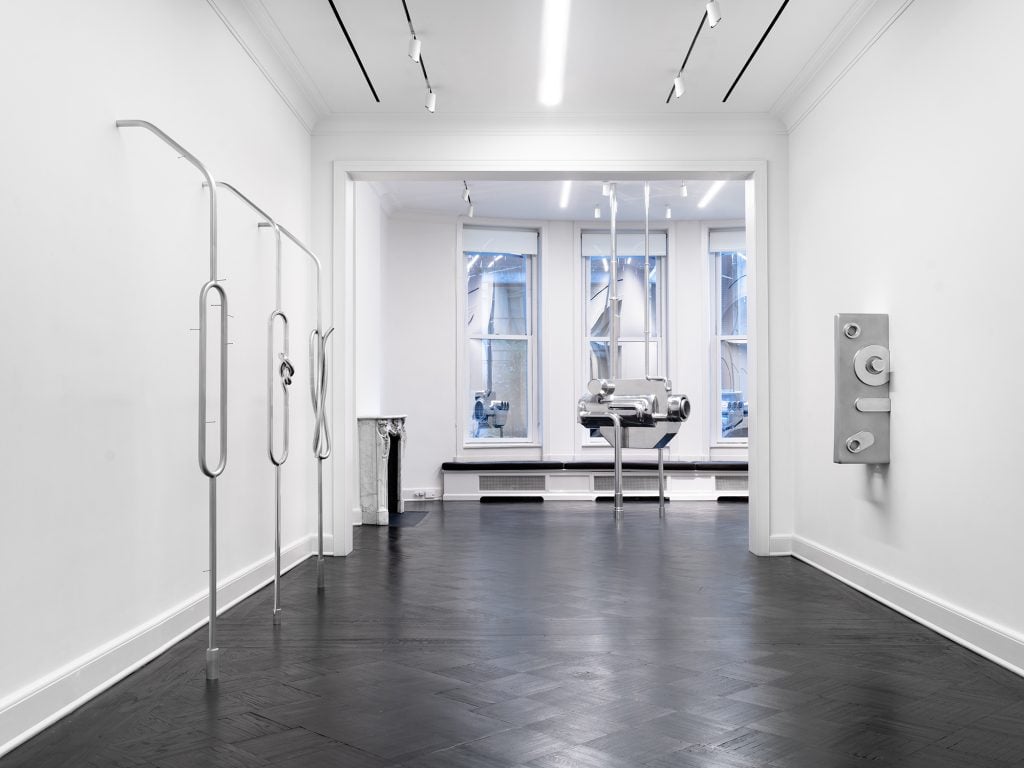
Installation view, Kristin Walsh, “The working end,” Petzel, 2024. Photo: Jason Mandella. Courtesy the artist and Petzel, New York.
I find it interesting that the cylinder bores never go all the way through. Like its function is not to function.
None of them could work, even if they tried. They’re modeled after objects that have functions that the sculptures themselves could never do. I want the objects to be about themselves. I see them as actors on a stage laboriously set up to basically perform no function. They’re performing this other minor function that appears to make no sense.
There’s a lot of precision and synchronicity, but as a whole, it’s in a seized state.
Yeah. Like, extremely, constipated and frustrated. A lot of restrained energy. It’s like this seizing of a moment. Like the seizing of an act never happening.
Their lack of function makes these objects ghostly, sort of haunting. Especially the thumping sounds from Engine no. 11, it feels like there’s another presence in the room with us.
One thing I really like about making kinetic sculptures is the sound. You’re like, “Oh, what was that?” And then, you go and investigate. It’s very subtle. But it’s less subtle when it’s the only thing in the space. I had these works installed in my studio for a long time and I kept scaring the shit out of myself. I would see my own reflection, and I was just like, “Oh God! There’s someone else in here!”

Kristin Walsh, Engine no. 12, (2024). Photo: Sebastian Bach. Courtesy the artist and Petzel, New York.
There’s a darkness that you engage with in your work. In moments it can feel like what’s left behind after death.
It’s sort of a dark time to be an artist. It feels like you try to engage socially and politically on topics, but you’re never really speaking to the people that can do something about it. There is something so disconnected about doing this type of labor. You’re alone but constantly thinking about the social implications of what you’re making but in a way you’re completely disconnected the entire time. It’s like the opposite of what it should be but how else would it be?
Your sculptures feel very earnest.
Someone said during a studio visit that I’m so embarrassed about being an artist that I can’t be sincere. I do think that can be true sometimes. I’m gonna make a joke out of it, or laugh at it and pretend that I don’t care, even though it’s sort of the only thing I care about.
One thing that runs through most of my work is an interest in clockmaking machining. It’s an old practice of machining with deeply opinionated views. Things like what materials shrink the least when heated or what materials keep the best time are constantly argued. There’s poetry in something that can be so precise but also loose. When I work with metal there’s an inherent rigidity because of the parameters of the material itself. But within the context of clockmaking, the metal goes so deep that it becomes expansive.
There is an uncanny element to the work. It’s disorientating. We know how these forms work in the subway but in this space they formally read like an inverted obelisk.
Someone once said in a critique that my work operates on an ape brain level where you’re just drawn to it. I want there to be a deeper conversation if a person wants to have it. But I know the work supports itself without the need of explanation.





